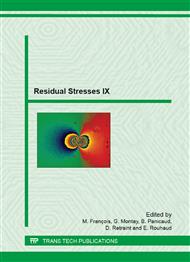p.494
p.500
p.506
p.512
p.518
p.525
p.532
p.538
p.544
Welding Simulation Used in the Design of Metallic Armor Systems
Abstract:
Welding steel armor reduces the armor materials protection capability. Several industrial and military welding standards exist for welding armor materials with the primary focus on joint strength rather than ballistic integrity.The Heat Affected Zone (HAZ) created by the welding process introduces vulnerabilities in the protection system. The process and designs that we have demonstrated include mitigation features that eliminate the ballistic degradation and provide uniform protection across all armor materials.In this study we used finite element simulation of the welding process to perform trade studies evaluating welded joint designs, and to show how the designs could be altered to both optimize armor performance and reduce welding heat input. A beneficial effect of reduced heat input was the corresponding reduction in welding-induced residual stresses, an overall reduction in assembly distortion in the assembly, and improvement of the armor performance.The simulated welding process included the creation of the heat affected zone and the development of residual stresses in the structure. ABAQUS finite element software was used for the simulation with the aid of an extensive material property database created over the wide range of welding temperatures.The finite element simulation predictions were validated and verified with excellent results by metallography and micro-hardness measurements. Live-fire ballistic tests were used as the final proof of measurable design improvements. Finite element welding simulation was shown to be an effective tool for improving upon standard welded armor designs, and above all in improving human safety.
Info:
Periodical:
Pages:
518-524
Citation:
Online since:
August 2014
Authors:
Permissions:
Share:
Citation:


